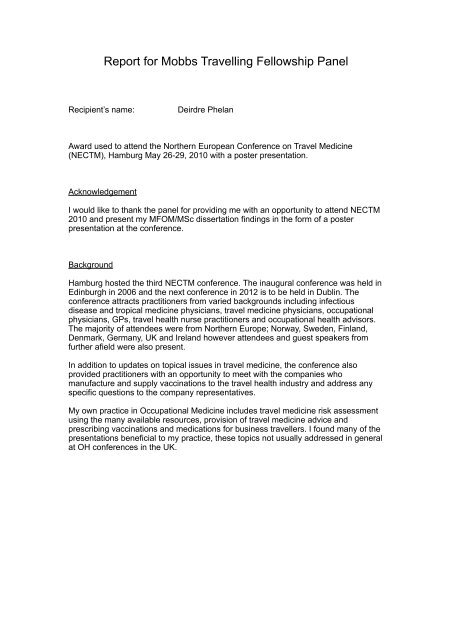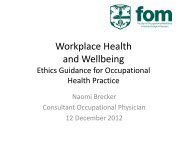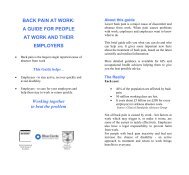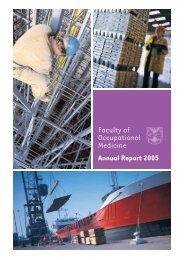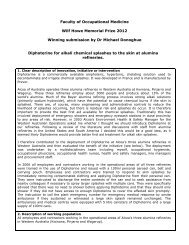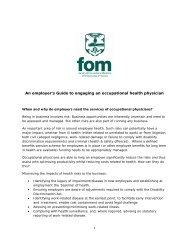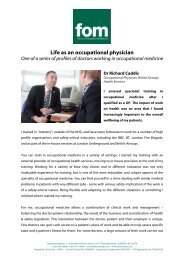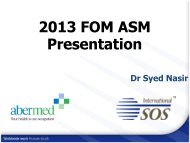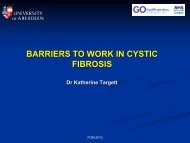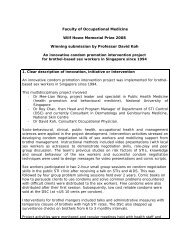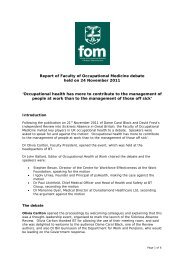(NECTM), Hamburg May 26-29 - Faculty of Occupational Medicine
(NECTM), Hamburg May 26-29 - Faculty of Occupational Medicine
(NECTM), Hamburg May 26-29 - Faculty of Occupational Medicine
Create successful ePaper yourself
Turn your PDF publications into a flip-book with our unique Google optimized e-Paper software.
Report for Mobbs Travelling Fellowship Panel<br />
Recipient’s name:<br />
Deirdre Phelan<br />
Award used to attend the Northern European Conference on Travel <strong>Medicine</strong><br />
(<strong>NECTM</strong>), <strong>Hamburg</strong> <strong>May</strong> <strong>26</strong>-<strong>29</strong>, 2010 with a poster presentation.<br />
Acknowledgement<br />
I would like to thank the panel for providing me with an opportunity to attend <strong>NECTM</strong><br />
2010 and present my MFOM/MSc dissertation findings in the form <strong>of</strong> a poster<br />
presentation at the conference.<br />
Background<br />
<strong>Hamburg</strong> hosted the third <strong>NECTM</strong> conference. The inaugural conference was held in<br />
Edinburgh in 2006 and the next conference in 2012 is to be held in Dublin. The<br />
conference attracts practitioners from varied backgrounds including infectious<br />
disease and tropical medicine physicians, travel medicine physicians, occupational<br />
physicians, GPs, travel health nurse practitioners and occupational health advisors.<br />
The majority <strong>of</strong> attendees were from Northern Europe; Norway, Sweden, Finland,<br />
Denmark, Germany, UK and Ireland however attendees and guest speakers from<br />
further afield were also present.<br />
In addition to updates on topical issues in travel medicine, the conference also<br />
provided practitioners with an opportunity to meet with the companies who<br />
manufacture and supply vaccinations to the travel health industry and address any<br />
specific questions to the company representatives.<br />
My own practice in <strong>Occupational</strong> <strong>Medicine</strong> includes travel medicine risk assessment<br />
using the many available resources, provision <strong>of</strong> travel medicine advice and<br />
prescribing vaccinations and medications for business travellers. I found many <strong>of</strong> the<br />
presentations beneficial to my practice, these topics not usually addressed in general<br />
at OH conferences in the UK.
<strong>NECTM</strong> 2010 Conference description<br />
I attended the conference on Thursday 27 th <strong>May</strong> and Friday 28 th <strong>May</strong> as pregnancyrelated<br />
flight restrictions prevented me attending the final morning on Saturday <strong>29</strong> th<br />
<strong>May</strong>.<br />
The opening plenary titled “Pandemic Influenza in 1918” included a high level<br />
discussion on the communication failings in Europe in relation to pandemic (swine)<br />
flu in 2009.<br />
Pr<strong>of</strong> Shanks from Australia, presented evidence from studies <strong>of</strong> military forces during<br />
the pandemic at the end <strong>of</strong> First World War, a time with a global movement <strong>of</strong><br />
soldiers, including the Australian Forces. It has been previously shown that although<br />
an estimated 50 million persons died worldwide during the 1918 influenza pandemic,<br />
the highest death rates were among young adults aged 20-40 years. This is the age<br />
group most commonly found in military service during this time but it was found that<br />
an increased length <strong>of</strong> time in military service was inversely proportional to the risk <strong>of</strong><br />
death, but not a reduced risk <strong>of</strong> illness. It was also noted in general that military<br />
nurses and medics had lower death rates although this cohort has increased contact<br />
with the infectious agent. This would suggest a protective effect <strong>of</strong> continued<br />
exposure to the virus over the time span <strong>of</strong> the pandemic waves.<br />
Dr Lammerding, a CMO for a German Cruise ship company gave a very interesting<br />
presentation on risk management <strong>of</strong> potential outbreaks <strong>of</strong> influenza like symptoms<br />
and gastro-intestinal symptoms on board cruise ships. The presentation was well<br />
illustrated by pictures <strong>of</strong> the facilities on board ship for dealing with such scenarios in<br />
addition to the adaptations in newly built ships to reduce spread <strong>of</strong> infection i.e.<br />
automatic flushing toilets and sensor taps in communal areas. The other interesting<br />
presentation in the Maritime <strong>Medicine</strong> plenary concerned “Piracy in Shipping”. Dr<br />
Nikolic, a physician to a large shipping company described the work environment <strong>of</strong><br />
oil tanker crews travelling around the African coast. He showed original footage <strong>of</strong><br />
one piracy attack. I found it interesting to observe the basic crafts used by the pirates<br />
at sea but also the types <strong>of</strong> crafts which are piracy targets. Cruise ship travellers are<br />
safe as cruise ships are difficult to board and too many persons on board who could<br />
over power the pirates!!<br />
The sponsored lunch time symposium on Thursday was in essence advocating<br />
vaccination in particular a new hepatitis A vaccine.<br />
Tick borne encephalitis (TBE) is not common in the UK although there was a case<br />
report <strong>of</strong> an unvaccinated traveller who contracted TBE while cycling through many<br />
European countries. For travellers to European countries in the summer seasons<br />
who will have contact with nature i.e. cyclists, picnics in park, hill walking in Russia,<br />
Austria, Czech Republic, Lithuania and Southern Germany, although the rate <strong>of</strong><br />
infection from a tick bite is estimated 3%. prophylactic vaccination is recommended<br />
as there is no cure for the disease which can cause aseptic meningitis and meningoencephalitis.<br />
However I have in the past prescribed this vaccine for long term<br />
business travellers to Austria, this presentation added to my understanding <strong>of</strong> the<br />
condition and the risks. At present winter sports enthusiasts need not be vaccinated<br />
however it was interested to see that the tick vector is being seen at increasingly<br />
higher altitudes in recent years,<br />
Borreliosis is a tick borne infection seen in the UK. The Polish perspective was<br />
interesting. There is a high incidence especially in North East Poland. Leisure tourists<br />
have an increased risk <strong>of</strong> contracting the condition as in the UK. Interestingly from an<br />
OH perspective Polish forestry workers have a seropositivity rate <strong>of</strong> 40-71% for<br />
borreliosis. Borreliosis is the number one infectious occupational disease and
occupational disease in forestry workers after HAVS and NIHL.<br />
The area where I gained most benefit from the conference was in relation to<br />
Japanese Encephalitis which was part <strong>of</strong> Friday morning’s plenary. Dr Buhl<br />
presented a general overview <strong>of</strong> this low incidence/high impact disease. As an<br />
occupational physician, most <strong>of</strong> my patient specific prescribing has been for JE<br />
vaccine due to the concerning safety pr<strong>of</strong>ile <strong>of</strong> the traditional vaccines. It is felt that<br />
the disease and related mortality is under reported due to lack <strong>of</strong> diagnosis and<br />
surveillance in endemic areas. As advised it is a low incidence disease compared to<br />
other traveller’s disease e.g. traveller’s diarrhoea, however the case fatality rate is<br />
estimated at 30% with serious long-term neurological sequelae for survivors.<br />
Similar to malaria, the reservoir is a mosquito but pigs also act as reservoirs.<br />
Therefore travellers to rural areas in endemic areas in Southeast Asia are most at<br />
risk. Prevention has similar properties to malaria prevention – bite avoidance, use <strong>of</strong><br />
mosquito nets, insect repellent and appropriate clothing, however unlike malaria<br />
prevention, a JE vaccine is available. Until now the general indication for vaccination<br />
involved more than a 4 week stay in an endemic area during the period <strong>of</strong><br />
transmission in rural areas. This was influenced by the concerns surrounding the<br />
safety pr<strong>of</strong>ile <strong>of</strong> the available vaccine.<br />
A new vaccine, Ixiaro, has been licensed for use in Europe and US. It is a vero cell<br />
derived vaccine and studies to date have shown an improved safety pr<strong>of</strong>ile<br />
compared to the previous vaccine. The risk <strong>of</strong> delayed reaction up to 10 days post<br />
dose associated with the previous vaccine has been eliminated and the dose<br />
schedule has been reduced to two doses, day 0 and day 28, with a booster currently<br />
advised at 12-24 months. The lunchtime plenary, sponsored by Novartis, the<br />
producers <strong>of</strong> Ixiaro, supported a lower threshold to advising JE vaccination with the<br />
new vaccine, with one study in the Journal <strong>of</strong> Travel <strong>Medicine</strong> 2009 advising that all<br />
expatriates travelling to endemic areas regardless <strong>of</strong> the transmission season should<br />
have the new JE vaccine. However the price per vaccine (approx €100) especially to<br />
self-paying travellers needs to be considered.<br />
Needless to say, Malaria featured highly at the conference with review presentations<br />
from both Peter and Jane Chiodini. “Blood, Sweat and Beer – The secret passions <strong>of</strong><br />
the Anopheles” was a fascinating presentation … I now know the best travel<br />
companions to bring on holidays to malaria endemic regions so as to reduce my bite<br />
risk!!<br />
I was somewhat disappointed by the attendance at the <strong>Occupational</strong> Health<br />
Symposium entitled “<strong>Occupational</strong> Health, Assistance, Repatriation”. Dr Alex Grieve<br />
gave, what was to me, a thought provoking presentation on the indication for postexposure<br />
prophylaxis for expatriates: HIV etc. PEP for HIV is synonymous with<br />
healthcare workers but I had not considered the potential indications in business<br />
travellers, particularly females travelling to areas with high HIV prevalence. It has<br />
certainly made me consider this area more closely however my practice is<br />
predominantly related to male business travellers where the risk pr<strong>of</strong>ile is somewhat<br />
different but not eliminated. I was not able to attend the presentations on risks for<br />
travellers to the World Cup in South Africa but I assume the risk <strong>of</strong> HIV contraction<br />
was covered in addition to the other prevailing health risks to football travellers.<br />
Dr Ge<strong>of</strong>f Tothill, CMO <strong>of</strong> First Assist described the company’s repatriation practices. I<br />
found this interesting as I previously worked for an organisation that used the<br />
company’s repatriation services.<br />
Dr Jones from Healthlink360 in Scotland described pre-departure screening <strong>of</strong><br />
expatriates for psychiatric disorders. The cohort described appeared predominantly
to be individuals planning to work abroad in a mission environment or NGO<br />
environment where screening for major mental health condition which would be<br />
incompatible with a successful expatriate experience with potentially disturbing<br />
experiences for expatriate colleagues is required. I had hoped that this presentation<br />
would have addressed minor mental health conditions which are more prevalent in<br />
business travellers who undertake short-term assignments. This was an area I<br />
considered for my MFOM/MSc dissertation before deciding to look at minor mental<br />
heath on repatriation, repatriation distress.<br />
Of all the presenters, the one I would most like to hear again was Pr<strong>of</strong> Rosling,<br />
Pr<strong>of</strong>essor <strong>of</strong> Global Health at the Karolinska Institute, Sweden. Pr<strong>of</strong> Rosling<br />
developed trend analysing s<strong>of</strong>tware 1 that converts international statistics into moving,<br />
interactive and engaging graphics, which has since been acquired by Google. He<br />
gave a presentation using the s<strong>of</strong>tware to illustrate the benefit <strong>of</strong> vaccines on global<br />
health. Statistics usually disinterest me but the overall presentation style had the<br />
audience, myself included, attentive and entertained by statistics.<br />
Summary<br />
From the above conference description, I accessed a varied selection <strong>of</strong> plenaries,<br />
symposia and presentations during my time at <strong>NECTM</strong> 2010 in <strong>Hamburg</strong>, which<br />
have increased my knowledge <strong>of</strong> travel medicine and other allied areas but more<br />
importantly will influence my future practice.<br />
Once again I wish to thank the panel for providing me with the opportunity to attend<br />
the conference and present my MFOM/MSc dissertation findings to a wider<br />
audience.<br />
Deirdre Phelan<br />
deirdrephelan@gmail.com<br />
1<br />
S<strong>of</strong>tware and examples <strong>of</strong> his presentations can be found at www.gapminder.org


